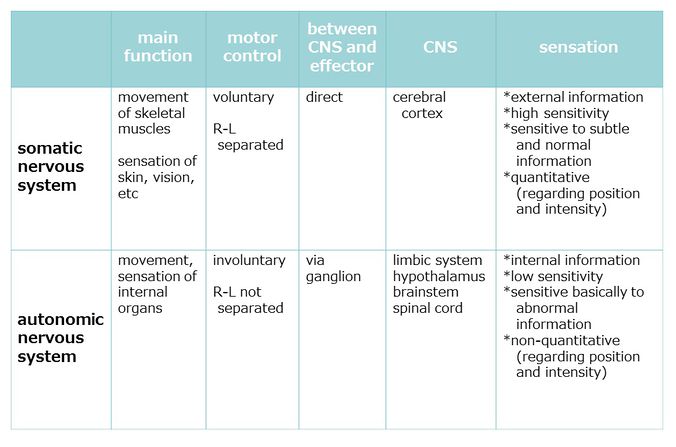Nerv06/introduction/autonomic nervous system and somatic nervous system
The peripheral nerves are functionally classified into autonomic and somatic nerves.
The peripheral nerve controlling autonomic function is the autonomic nerve. The autonomic nervous system is centered in the hypothalamus. Autonomic function involuntarily controls the activities of each organ (such as the heart rate and gastrointestinal motility) and maintains the internal environment (such as the body temperature, blood pressure, pH of the body and the amount of water). The somatic nervous system is the peripheral nervous system directly connected to the cerebral cortex and thus consciousness.
Functions such as feeling a touch to the skin and raising hands are functions of the somatic nervous system.
Challenge Quiz
The autonomic nervous system controls the skeletal muscles.internal organs .
The somatic nervous system controls the skeletal muscles. internal organs .
The autonomic nervous system is in charge of voluntary.involuntary movement.
The somatic nervous system is in charge of voluntary. involuntary movement.
The sensation by the autonomic nervous system is quantitative.non-quantitative .
The sensation by the somatic nervous system is quantitative. non-quantitative .
Contracting muscles are a function of the autonomic.somatic nervous system.
Blood pressure elevation is a function of the autonomic. somatic nervous system.
The center for the autonomic nervous system is in medulla. pons. midbrain.hypothalamus. thalamus. cerebellum. cerebral basal nuclei. cerebral limbic system. cerebral cortex .
The center for the somatic nervous system is in medulla. pons. midbrain. hypothalamus. thalamus. cerebellum. cerebral basal nuclei. cerebral limbic system.cerebral cortex .
In the autonomic nervous system, right and left are clearly.not so clearly localized.
In the somatic nervous system, right and left are clearly. not so clearly localized.
